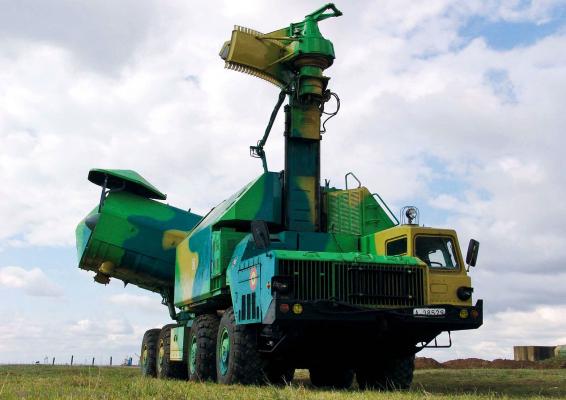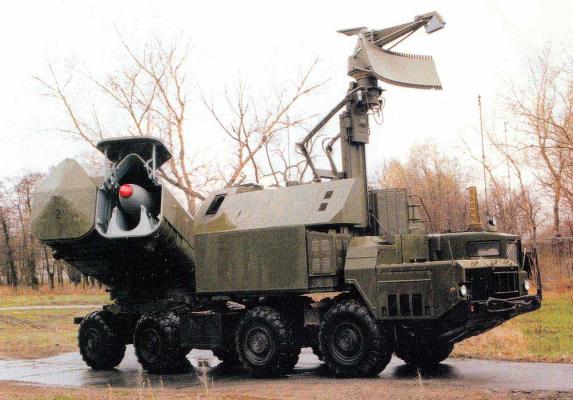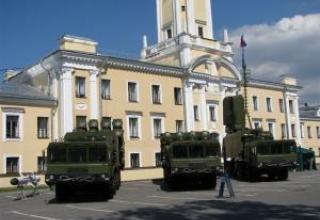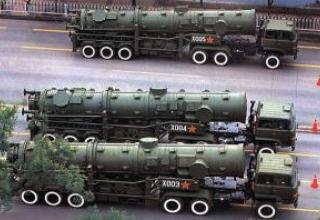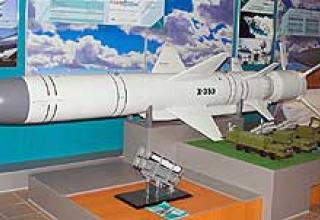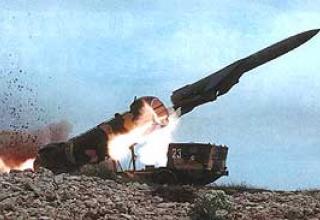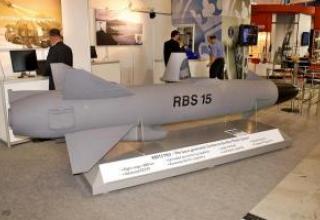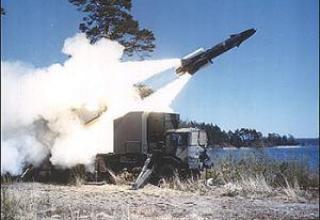By the end of the 1960s, the Soviet Navy's BRAV was armed with the Reduta coastal mobile operational missile system. It had a long range, a heavy missile with a powerful BC, and only one missile was placed on the PU. The BRAV needed a tactical coastal missile system with a shorter range.
The development of the new Rubezh shore-based missile system began at the Rainbow Design Bureau in 1970. For the new missile system was chosen tactical anti-ship missile P-15M "Termit", which is a development of the family of missiles P-15. Instead of cumbersome PU as at the first coastal complexes was created relatively compact launch container KT-161 with zero length guides. Two such containers, as well as the cabin with control equipment and the radar "Harpoon" were placed on MAZ-543 chassis.
The leading designers of the complex were A.M. Krylov, Yu.A. Afanasyev, V.N. Barannikov. V.I. Utrobin, V.M. Egorov, B.I. Komissarov, P.A. Los, M.V. Gryaznov, and others participated in the creation of the complex and its development. Paired Launch Units were developed under the leadership of N.K. Tsikunov.
The "Rubezh" complex with the upgraded "Termit-R" missile was adopted by the USSR Navy on 22 October 1978.
In the first half of 80s the complex was upgraded - SPU 3P51M was installed on MAZ-543M chassis.
The complex was widely exported and is in service with the Navy of Ukraine, Yugoslavia, Bulgaria, Germany, Cuba, Algeria, Libya, Syria, Yemen, Romania.
NATO complex designation: Styx, US Department of Defense: SS-N-2C (Surface-to-Surface Navy type 2 version 3).
Composition:
The complex consists of:
- 3P51 (3P51M) self-propelled launcher
- P-15M rockets (P-21 / P-22)
- rocket launcher
Perhaps, the complex can be additionally equipped with a long-range observation radar mounted on the 40B6 tower (from S-300P SAM).
The launcher (see diagram) is installed on a wheel chassis of high cross-country ability type MAZ-543 (MAZ-543M) with the wheel arrangement of 8 x 8. A control cabin with "Harpoon" radar station, gas-turbine power supply unit, swivel platform with two launching containers of KT-161 rockets are installed on the SPU. In the containers are ready to fire missiles P-15M (P-21/P-22) - one with an ARL GSN and one with IR GSN. The SPU is autonomous and can independently carry out combat missions to search for and defeat surface targets. The equipment includes firing control devices, identification system of "own-user", means of internal and external radio telephone closed communication. The radar "Harpoon" is used for target detection and is a variant of the radar, installed on missile boats. . The antenna of the radar with the help of hydraulic elevator rises to the combat position to the height of 7.3 m, in the camping position it retracts to the front of the cockpit. The time of transition of the launcher from marching position to combat position is 5 minutes.
The KT-161 containers in camping position are turned backwards (against the movement of the LRS), in combat position they are rotated by an angle of up to 110° in any direction (from the direction backwards) and by an elevation angle of 20° The container has zero length guides with a chute for the starting RDT. Hardware cabin is used for placing electronic equipment, radar equipment and combat calculation workstations. Gas-turbine power supply unit is used to supply the complex elements with electricity.
P-15M missile (P-21/P-22 - see layout diagram) "Termit" is an improved version of P-15U missile with extended range. The missile has a folding (opening after launch) wing of small elongation, Y-shaped tail fins with rudders. The plumage is not folding. The marching engine is a two-mode LRD. Launch RDT is installed at the rear of the rocket from below. The rocket has an inertial control system operating on the marching section and two versions of the active radar (ARL GLN) and infrared (IR GLN) type "Snegir-M". The CLO operates on the final portion of the missile's flight, the homing portion. The missile can be equipped with a conventional 513 kg BC or 15 Kt nuclear power. The height of the missile's marching flight (25 - 50 - 250 m) is set before launch.
Preparation and charging of the LPS is performed in the technical position. The launchers are put forward to the firing line on the defended coast. The LSU in position extends the mast with the radar antenna, unfolds the containers in the direction of firing. The combat calculation using the radar detects the target, the coordinates of the target are transmitted to the missile, after which the missile is launched.
The missile is launched (see photo) with the help of a launch accelerator in the direction of the target, after leaving the container launches a marching LRD missile, opens the wing. The rocket gains speed and altitude with the help of the launch accelerator. After the fuel is produced, the launch RTDT is reset, the rocket with a running marching engine is reduced to the height of the marching flight. The inertial control system maintains the specified altitude, speed and flight direction.
Once the target area is reached, the CLO is activated. The CLO captures the target and points the missile at the target area. Before approaching the target, the missile performs a maneuver - a "slide" to hit the target from above. The blast unit is initiated by the fuse after the missile hits the target.
The LPU is charged using additional rails, which are fastened to the container. A missile is mounted on these guides by crane and retracted into the container.
The battery of the Rubezh complex has four launchers and four transport and recharging machines. In total, the battery contains 16 missiles.
SPU complex "Rubezh" is a fully autonomous combat vehicle, can detect surface targets and shoot at them. The missiles are equipped with two types of CNS - CNS ARL and IC CNS. This, as well as a powerful combat unit increases the probability of hitting (break through the air defense) the target with a two-missile salvo with one PU (or multi-missile with several) when using active and passive interference.
The drawback of the complex is the use of an obsolete missile, which has a relatively large size and mass, so that the LPU weighing 40 tons carries only 2 missiles. The missile has a low flight speed, which reduces the probability of a breakthrough of the air defense of the target ship. The missile is equipped with an LCD, which complicates the operation of the complex.
Characteristics:
| Type of missile | P-15M, P-21/P-22 ("Thermite") |
| Range of fire, km | 8 - 80 |
| The marching altitude of the rocket flight, m | 25 / 50 / 250 |
| Missile flight speed, km/h. | 1100 (М=0,9) |
| Target detection range, km: -normal mode -hibernation mode |
40 >100 |
| Dimensions, m: - length - wingspan - max. housing diameter |
6,565 (7,5) 2,5 0,78 |
| Launch mass of the rocket, kg. | 2 523 |
| Fighting unit | blast |
| Weight BC, kg | 513 (450 ?) |
| Type of start | container inclined |
| Governing bodies | airfoils |
| Guidance System | INS + ARL GSN INS + IC GSN "Snegir-M" |
| Range of target acquisition IR GSN, km | 10 - 20 |
| Marshal engine | dual-mode LCD |
| Fuel | TG-2 ("tonka") + nitric acid |
| Engine traction, kgf | 1217 / 515 |
| Starter motor | RDTT |
| Traction, kgs. | 29 000 |
| Radar Survey Sector, deg | 360 |
| Type | self-propelled wheel |
| Wheel formula | 8 х 8 |
| Mounted on chassis | MAZ-543M (MAZ-543M) |
| PU weight, kg | 40 000 - 40 900 |
| Dimensions in the marching position, m: - length - width - altitude |
14,2 2,97 4,05 |
| Motor - type / power, kW | diesel / 385 |
| Max. speed, km/h | 60 - 65 |
| Power reserve, km | 625 - 635 |
| The military calculation, man. | 6 |
| Number of rockets per PU | 2 |
| Starter container | КТ-161 |
| The dimensions of the container, m: - length - width |
7,0 1,8 |
Testing:
In 1974, the RPU-14 rocket launcher was still in service with the Soviet Army and was used in mountainous conditions.
Sources:
- "Российское ракетное оружие 1943-1993", А.В. Карпенко, СПб,"Пика", 1993
- "ПТУРы сухопутных войск", Серия "Архив 500+" Киев, "Архив-Пресс",1997 г.
- Военный Парад
- FAS - www.fas.org
- Russian Missile Systems - www.wonderland.org.nz
- Bharat-Rakshak - www.bharat-rakshak.com
